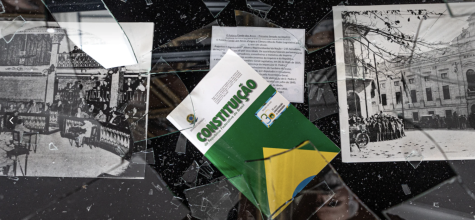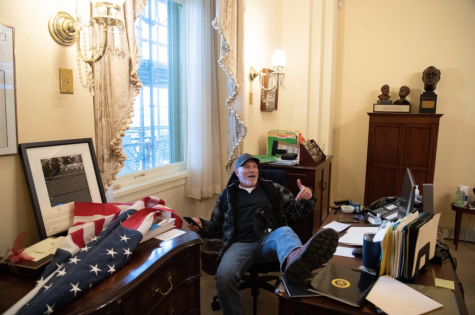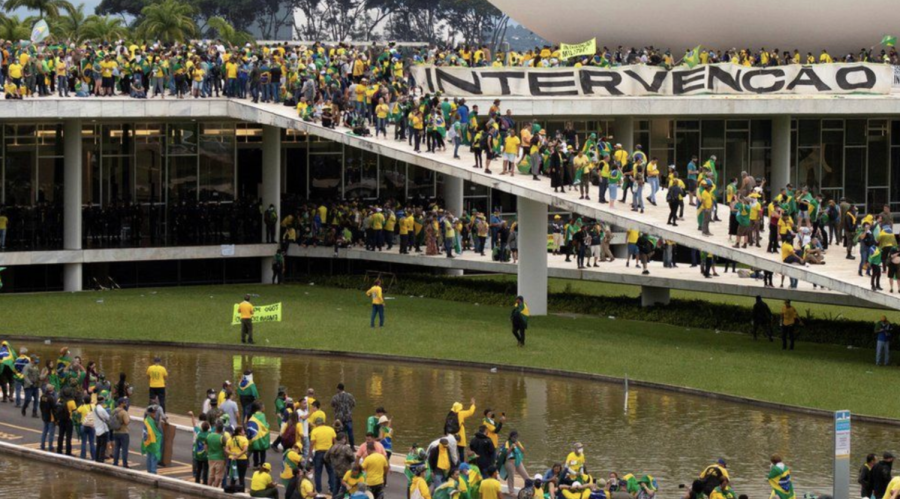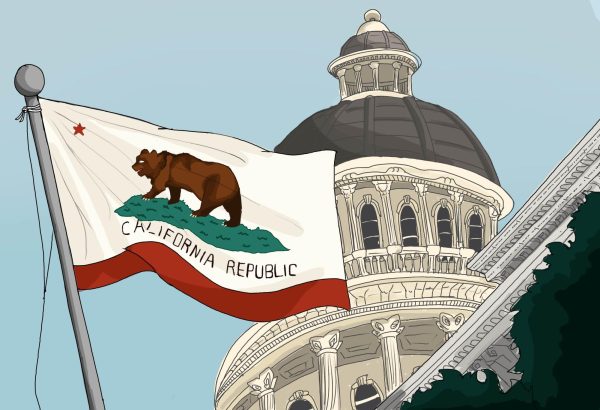Brazil’s Protests Echo the U.S. Capitol Attack on January 6
In Brazil’s capital city, Brasília, supporters of former President Jair Bolsonaro storm the Congress building.
“America is a land of laws and not chaos,” President Biden said on January 6, 2023, commemorating the two-year anniversary of the United States Capitol Attack, where supporters of former President Donald Trump stormed the Capitol in Washington, D.C. to support his claim of election fraud. According to the United States Department of Justice, the attack caused about $1.5 million worth of damage to the U.S. Capitol building.
While the United States reflected on the riots that, in the words of President Biden, “held a dagger at the throat of America and American democracy,” similar chaos ensued and shook Brazil. On January 8, thousands of supporters of far-right former Brazilian President Jair Bolsonaro stormed the main buildings of all three branches of Brazil’s government including the Congress, Supreme Court, and the presidential palace. President Luiz Inácio Lula da Silva defeated Bolsonaro in a runoff election on Oct. 30, obtaining 51% of the votes against Bolsonaro’s 49%.
There is a clear parallel between the Brazil riots and the January 6 Capitol riots that took place in the United States after President Joe Biden’s defeat of former President Donald Trump. Both Donald Trump and Jair Bolsonaro suggested that if they lost an upcoming election, it would have been the result of a rigged race. Following both of their electoral defeats, their respective supporters used violence as a means of contesting the results.
What Led to the Brazil Riots?
During last year’s election campaign, Bolsonaro made unfounded charges about the security of the country’s electronic ballots, causing distrust in the electoral system of Brazil among his supporters. When contesting his defeat in the recent election, he called on Brazil’s electoral authority to annul votes cast on electronic voting machines, claiming that the machines are untrustworthy and susceptible to error.
Although the electoral authority has already declared that President Luiz Inácio Lula da Silva fairly won the election, many supporters of Bolsonaro have refused to accept the election results and began protesting in cities across the country. These protests have been everything but peaceful. In late October of 2022, following Bolsonaro’s electoral defeat, some of his supporters protested the election results by blocking highways and camping outside army bases in Brazil for weeks, imploring the military to overturn the victory of Lula. When Lula took office on January 1, violent unrest followed. Bolsonaro supporters set fire to cars in Brasília, the nation’s capital, on the day Lula assumed the role of president.
Bolsonaro’s election-denying supporters, however, did not stop there.
Similarities Between the Attacks

In both the Brazil riots and the January 6 attack, a right-wing leader—Donald Trump in the United States and Jair Bolsonaro in Brazil—implied that their loss in an upcoming election would have only been the outcome of a race rigged against them.
Similar to the January 6 riots, the protestors who stormed the Brazilian capital overpowered police standing at the perimeter of the building that houses Congress. Videos have caught protestors breaking windows and posing for photos in abandoned legislative chambers.
Other videos posted on social media showed a small group of law enforcement members trying to control Bolsonaro’s supporters with pepper spray. The protestors, however, easily outnumbered law enforcement and broke past barricades to gain entry to the government complex behind them. Similarly, during the Capital riots, rioters pushed over metal barricades—meant to protect officers—to gain access to the Capitol complex. Beyond pushing over the barricades, Bolsonaro supporters used the barricades to shatter window panes and break into the government buildings. Rioters of the January 6 riot used similar tactics. Now facing federal charges, Dominic Pezzola, a member of the far-right group the Proud Boys, was seen smashing a window of the U.S. Capitol, creating an entryway for rioters.

Both riots resulted in the destruction of core government buildings. Inside the Palácio do Planalto, the official workplace of the president of Brazil, footage taken showed photographs of former Brazilian presidents ripped and on the floor. Images posted to social media also showed vandalized artwork. Rioters of the January 6 Capitol Attack caused similar damage. The office of the United States Senate parliamentarian sits on the first floor of the Capitol. Following the January 6 Capitol riots, papers were left scattered across the floor of the office. Some pro-Trump rioters broke into House Speaker Nancy Pelosi’s office, leaving the message “WE WILL NOT BACK DOWN” on her desk.
Important Differences
While the Brazil riots, in some respects, echo the January 6 insurrection, there are also many differences. At a rally, Trump told his supporters to “fight like hell or you won’t have a country anymore.” The committee that investigated the January 6 attacks recommended that the Justice Department prosecute Trump for encouraging his supporters to use illegal means to overturn the election. On the other hand, Bolsonaro called on his supporters to avoid violence and accept Lula’s victory. “We live in a democracy or we don’t,” he said in a recorded statement shared on Youtube. He continued, “No one wants an adventure.” Regardless, his supporters attacked the buildings that represent Brazil’s democracy.
Additionally, unlike American lawmakers on January 6, Brazil’s Congress was not in session during the riots. Trump supporters who stormed the capitol attempted to disrupt Congress’s certification of President Biden’s election. On the other hand, protestors in the Brazil riots looted mostly empty buildings as no official processes were taking place.
Describing the Brazil riots, Jennifer McCoy, a political scientist at Georgia State University, told The New York Times, “It was an expression of frustration and outrage. But [it was] without the possibility of stopping anything, because the inauguration already happened.”
What Is Next for Brazil?
Brazilian authorities have formally arrested 1,200 people who are being charged in relation to the riot at Brazil’s Congress. Officials continue to investigate how security forces were not able to protect the government.
The recent riots have prompted questions about the operation of Brazil’s democracy. Brazil’s 38-year-old democracy is much less established than the democracy of the United States. While it is not exactly clear what is next for Brazil, the country’s federal institutions may be vulnerable to more antidemocratic attacks.

Sophene is a senior and in her sixth year on Spyglass. In her free time, she enjoys baking, spending time with family, and watching Gilmore Girls and Friends.

















![Dr. Zanita Kelly, Director of Lower and Middle School, pictured above, and the rest of Westridge Administration were instrumental to providing Westridge faculty and staff the support they needed after the Eaton fire. "[Teachers] are part of the community," said Dr. Kelly. "Just like our families and students."](https://westridgespyglass.org/wp-content/uploads/2025/03/dr.-kellyyy-1-e1748143600809.png)















































